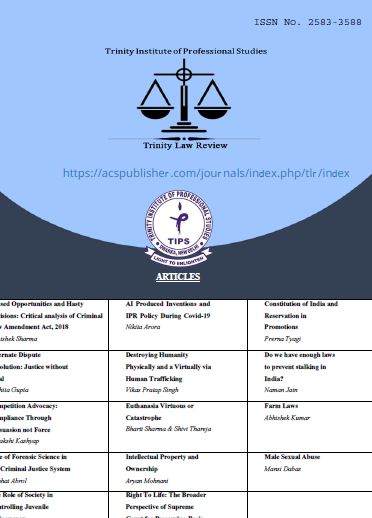Enhancing Accountability Mechanisms in NGT: Constitutional and Legisla tive Reforms
DOI:
https://doi.org/10.48165/tlr.2025.5.1.5Keywords:
protect, natural, dis putes, ensure, gaps, imposedAbstract
The National Green Tribunal (NGT) was established as a specialized body to address environmental disputes and ensure the effective enforcement of environmental laws in India. However, challenges related to accountability and execution have often impeded its ability to function optimally. This paper examines the accountability mechanisms of the NGT within the framework of India’s constitutional provisions and statutory mandates. It highlights the gaps in its current regulatory and enforcement structures that hinder effective environmental governance. The study explores relevant constitutional principles, such as the directive under Article 48A to protect and improve the environment and the fundamental duty under Article 51A(g) to safeguard natural resources. Additionally, it critically evaluates the NGT’s quasi-judicial status and the limitations imposed by legislative ambiguities and inadequate administrative support. The paper proposes constitutional and legislative reforms, including amendments to enhance the NGT’s powers for monitoring compliance, increasing transparency and ensuring judicial review of its decisions. By strengthening accountability mechanisms, the NGT can emerge as a more robust institution capable of upholding environmental justice and addressing pressing ecological concerns.
References
Das, P. (2021). Strengthening institutional accountability in environmental governance: The role of the National Green Tribunal. Indian Environmental Review, 14(2), 89–105.
Singh, V. (2020). Comparative analysis of environmental tribunals: Lessons for the National Green Tribunal. Journal of Environmental Law and Policy, 9(1), 45–62.
Sharma, A. (2021). Enhancing the enforcement powers of the NGT: A pathway for better environmental justice. Law and Governance Studies, 18(3), 33–50.
Kohli, M. (2020). The effectiveness of NGT decisions: An evaluation of compliance mechanisms. Environmental Policy Review, 13(2), 67–81.
Chaturvedi, S. (2019). Public participation and accountability in environmental adjudication: A case study of the National Green Tribunal. Social and Legal Perspectives on Environmental Justice, 7(4), 112–127.
Rao, N. (2020). Constitutional recognition of environmental rights: Strengthening the NGT’s role. Constitutional Law Insights, 15(1), 21–39.
Mishra, P. (2021). Integrating international best practices into India’s environmental governance framework. Comparative Studies in Environmental Law, 11(2), 88–102.
Verma, A. (2020). Addressing delays in the execution of NGT orders: Challenges and recommendations. Indian Journal of Environmental Governance, 10(3), 55–70.
Jain, T. (2019). Monitoring and compliance: Improving the implementation of NGT orders. Green Tribunal Studies, 8(1), 96–109.
Thompson, R. (2021). Comparative perspectives on environmental tribunals: Lessons for India’s NGT. International Journal of Environmental Law, 19(2), 34–49.




